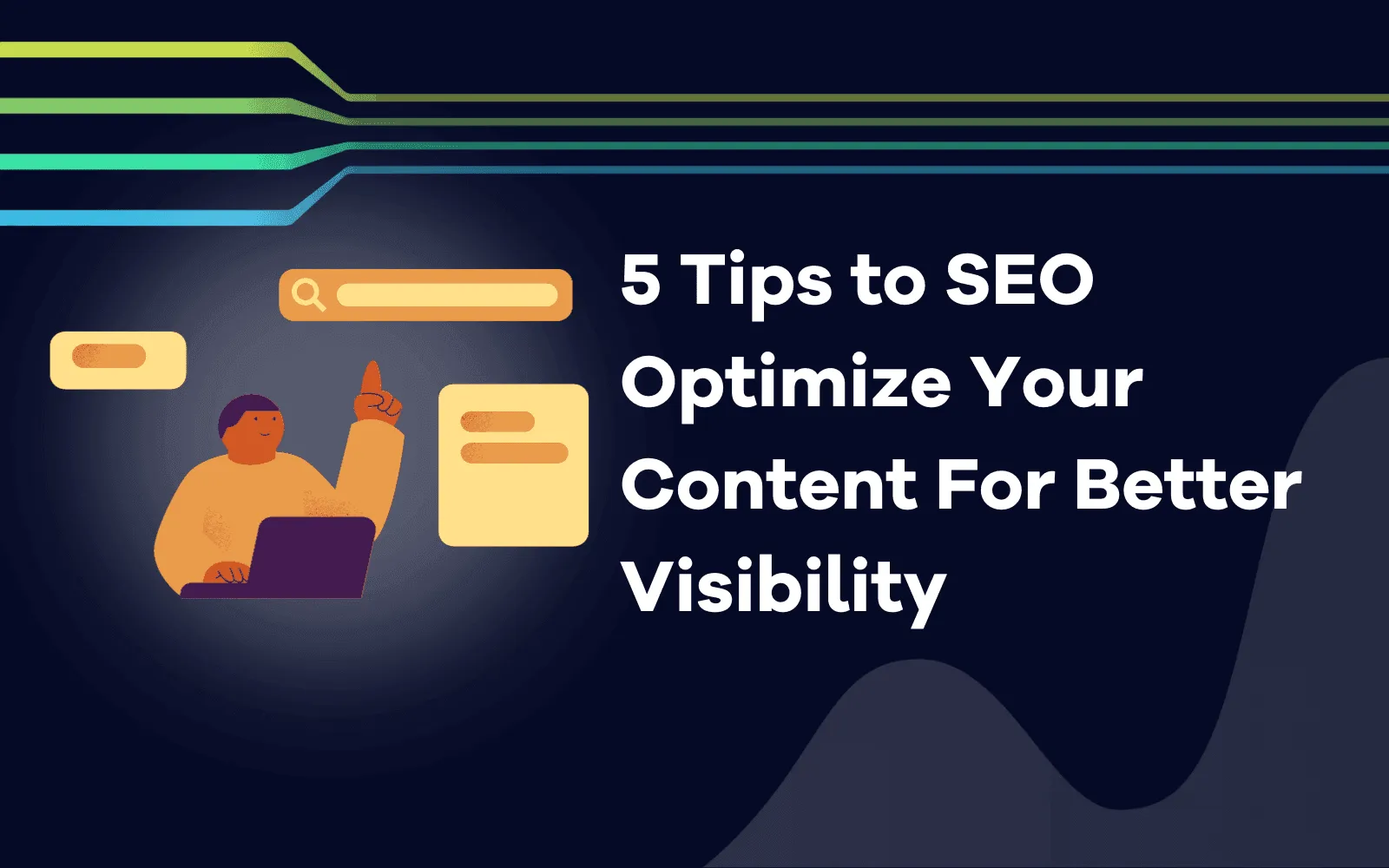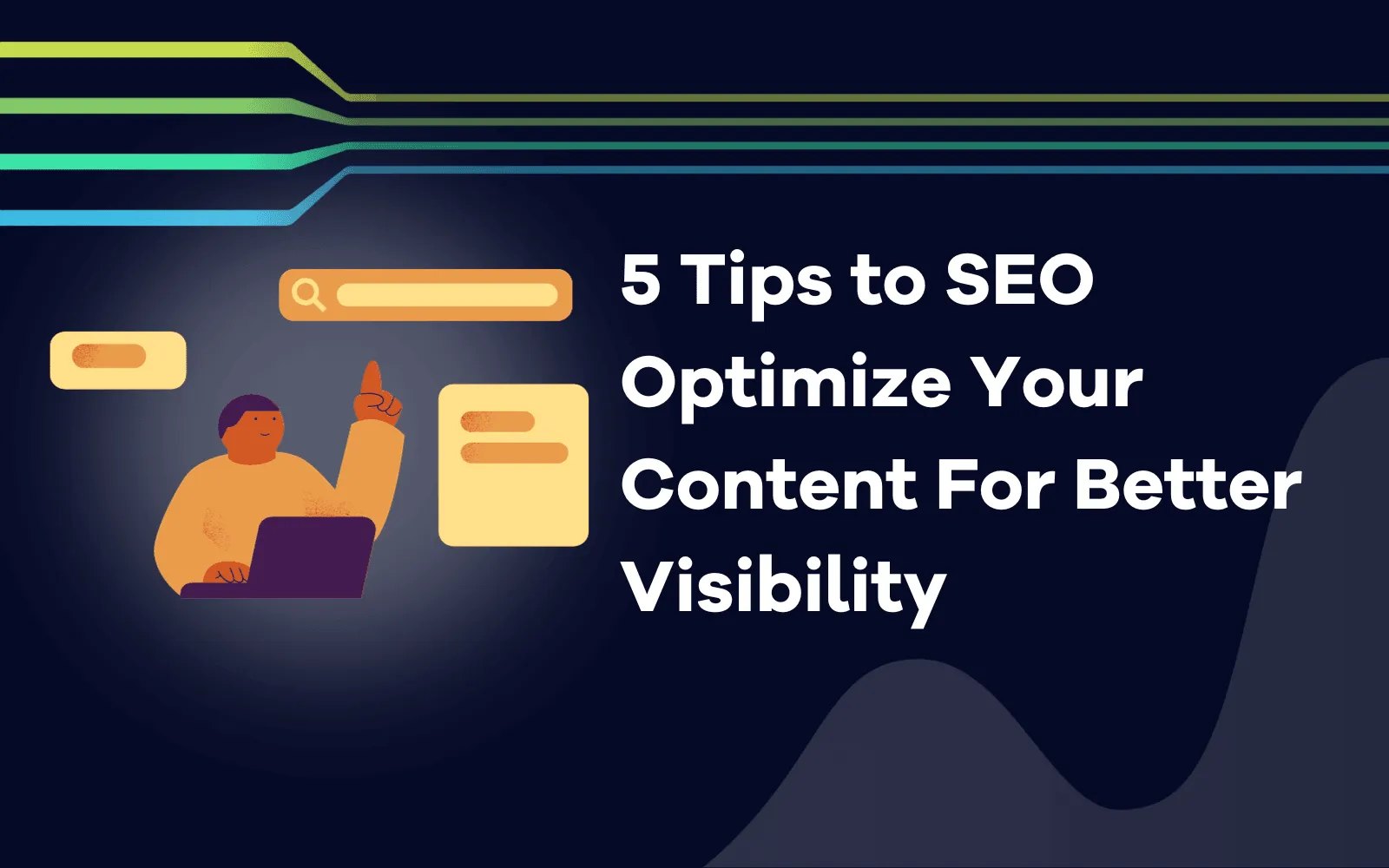
5 Tips to SEO Optimize Your Content For Better Visibility

Lilit
September 27, 2023
Learn how to optimize your content for maximum visibility with our 5 expert tips. Elevate your online presence and drive more traffic today

Looking to enhance your website's visibility and attract more visitors? Optimizing your content for search engines is a smart strategy. By aligning your content with what users are searching for and integrating relevant keywords thoughtfully, you can significantly improve your search result rankings.
Obtaining high-quality backlinks adds credibility to your website, and consistently updating your content keeps it fresh and engaging. The numbers speak for themselves, as research shows that 47% of articles with advanced headings belong to the group of top-performing organic content.
So, get ready to pave the path for organic traffic and elevate your website's online presence. Keep reading the article to discover the importance of content optimization and getting actionable insights on refining your website's SEO to draw in potential customers.
Importance of optimizing content for search engines
First things first, let's discuss why SEO-optimized content matters for your website:
✓ Better visibility
SEO improves how search engines see your content so it appears higher up. That means more people discover your site.
✓ Attract interested visitors
By using the right keywords, you draw in people who are looking for what you offer. It's like getting the attention of folks who want exactly what you've got.
✓ User-friendly experience
Optimizing leads to faster site loading and improved user-friendliness, enhancing customer satisfaction index and encouraging longer visitor engagement.
✓ Build trust
Being higher in search results makes your site look trustworthy. People tend to rely on what they find up top.
✓ Stand out
With good SEO, you get ahead of competitors. Your site becomes a top choice for those searching for what you provide.
How to SEO optimize your content to increase visibility
After discussing the importance of optimizing your content, it's time do discuss actionable steps that will help you successfully boost your website's SEO and improve your online presence.Conduct Keyword Research
Conducting keyword research is the first step in content optimization. It helps you identify valuable keywords to attract organic traffic by matching what your audience is searching for.
Here are several steps that you should follow to make the process effective:
✓ Brainstorm initial keywords
Use your knowledge and intuition to generate a list of potential keywords that you think people use to search for content related to your topic.
✓ Use keyword research tools
In the next step, use keyword research tools to find more relevant keywords and get data on search volume and competition. Employ AccuRanker's keyword rank tracker to monitor performance, improve rankings, and stay ahead of competitors.
✓ Analyze search intent
Moreover, consider the intent behind each keyword. Are users looking for information, trying to make a purchase, or seeking a specific service? Understanding search intent will help you tailor your content to meet users' needs effectively.
✓ Assess keyword difficulty
Additionally, evaluate the competitiveness of each keyword. Choose a mix of high, medium, and low-difficulty keywords to optimize your chances of ranking well in search results.
✓ Prioritize and refine keywords
Furthermore, based on search volume, relevance, and competition, prioritize the keywords that align best with your content goals. You may also choose to focus on long-tail keywords, which are more specific but often have higher conversion potential.
✓ Use variations and synonyms
In the last step, include keyword variations and synonyms naturally in your content to capture a broader audience and avoid repetitive language.
Overall, with thorough keyword research and strategic keyword implementation, you can enhance your website's visibility, attract targeted traffic, and boost your overall SEO efforts to achieve online success.
✓ Craft High-Quality Content
The next crucial step in optimizing SEO content is crafting high-quality content. Start the process by delving into your audience's needs, preferences, and pain points. By addressing these interests and offering practical solutions, you can write engaging and valuable content that resonates with this audience. When sharing your content via email, consider using the SPF record checker to ensure that your messages successfully reach the email recipients' inboxes.
In addition to this, you need to conduct in-depth research on the topic, utilizing reputable sources and data to establish authority. In case you want to optimize an e-commerce store selling organic skincare products, focus on crafting high-quality product descriptions and informative blog posts. Conduct research to highlight unique benefits, natural ingredients, and skincare solutions while using reputable sources for authority.
Moreover, focus on readability and user experience. Write in a clear, concise manner with simple language. Break up large blocks of text with headings, subheadings, and bullet points for easy scanning.
Lastly, use visuals like images, infographics, and videos to enhance engagement and convey complex information effectively.
 Source: Zipdo
Source: Zipdo✓ On-Page Optimization
The next significant aspect of content enhancement involves On-Page optimization. This means making direct improvements on your web pages to make them perform better and rank higher on search engines.
✓ Write effective meta titles and meta descriptions
When you're working on your website, don't forget about title tags and meta descriptions – they're super important for on-page SEO. These show up when people search online and can make a big difference in how many people click on your site and see it.
So, here's what you do: Write short and clear meta descriptions that tell exactly what your page is about. Add in some extra keywords that fit the main topic so your page shows up when people search for related stuff. It's like a road sign that helps more people find and visit your site. Employ a white label content assistant to craft concise meta descriptions for clarifying your page's content.
✓ Pay attention to the URL structure
Create clean and user-friendly URLs that include your primary keyword and provide a clear indication of the content's topic.
✓ Don't forget about heading tags
Use header tags (H1, H2, H3, etc.) to structure your content logically, and include your primary and secondary keywords in these headings where appropriate.
✓ Optimize images
Optimize images by using descriptive file names and adding alt tags that include relevant keywords, enhancing accessibility and SEO.
✓ Ensure mobile responsiveness
Ensure your website is mobile-friendly to cater to the increasing number of users accessing content on mobile devices.
✓ Utilize Internal and External Links
Links on your website do two important things: they help people find your site in searches and make it easy to explore. When you put internal links inside your site, it's like making paths for visitors to follow. These paths use clear words so your site looks organized and trustworthy.
External links to other trusted sites make your content look more believable. But don't use too many because it might confuse people and search engines. It's like having too many road signs in one place – it can be overwhelming.
By using both types of links smartly, you make your site better for people and also for search engines. This means people can find things easily, and your site might show up higher in search results. So, think of links as helpers that make your site more reliable and interesting to explore.
✓ Focus on long-tail keywords
 Source: Backlinko
Source: Backlinko
Focusing on long-tail keywords is essential for SEO content strategy and content optimization. They have less competition, bring highly targeted traffic, and improve conversion rates. By tailoring content to specific queries, you enhance user experience and establish niche authority.
Long-tail keywords also facilitate voice search optimization, as people often use more natural language in voice queries. Combining them with broader keywords creates a diversified strategy for SEO success, allowing you to cater to both short-term and long-term goals.
Thorough research is key to identifying relevant long-tail keywords that resonate with your target audience. Utilize keyword research tools to uncover specific search phrases and understand user intent better. Implementing these keywords strategically throughout your website's pages, blog posts, and other content can significantly boost your search engine rankings.
As a result, you'll attract more qualified traffic, increase engagement, and improve your chances of achieving your online objectives. With the ever-evolving landscape of search engine algorithms, focusing on long-tail keywords ensures that your content remains relevant and competitive.
✓ Build a backlinking strategy
Building a backlinking strategy is another crucial step for improving your website's authority, visibility, and search engine rankings. Here are six steps to create an effective backlinking strategy:
✓ Content Creation
Produce high-quality, valuable content that others would naturally want to link to. Informative articles, guides, infographics, and original research are excellent examples.
✓ Outreach
Reach out to relevant websites, influencers, and bloggers in your industry. Introduce yourself, share your content, and politely ask for backlinks or collaborations.
✓ Guest Blogging
Contribute guest posts to authoritative websites within your niche. Include links back to your site in the author bio or within the content if allowed by the website's guidelines.
✓ Broken Link Building
Identify broken links on relevant websites and offer your content as a replacement. This approach can help you earn valuable backlinks while providing a solution to webmasters.
✓ Build Relationships
Establish relationships with other website owners and industry professionals. Networking can lead to organic backlink opportunities and potential collaborations.
To sum up
SEO optimization plays a crucial role in increasing organic traffic to your website by improving search engine rankings and visibility. By creating high-quality and engaging content, you enhance user experience, leading to longer website visits and higher chances of conversion.
Effective SEO strategies give you a competitive edge, making it easier for your content to stand out in a crowded digital landscape. Implement these tips to improve your content visibility, attract more organic traffic, and enhance your online presence effectively. Follow these tactics to get a competitive advantage and maintain long-term success in reaching a wider audience.
Related blog posts

5 LLM Visibility Metrics You Should Track in 2026
SEO is now both about ranking in search engines and being visible in LLMs. We give you five visibility metrics every SEO should track in 2026.
3 December 2025Is LLM Tracking Relevant for You?
LLM tracking is not just for SEOs. It is also relevant for content teams, agencies, marketing leadership, and communication teams. Learn why here.
26 November 2025
How to Find the Best Prompts to Track for AI Visibility
Do you want to start tracking prompts to optimize your AI visibility? We give you seven practical ways to identify relevant prompts to track in LLMs.
9 November 2025
